Water Quality Veteran Shares Memories of a 40 Year Career
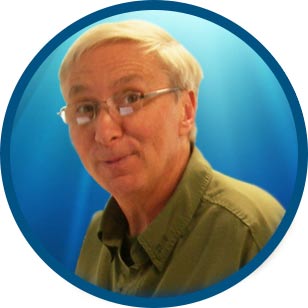 At the end of 2015 Mr. Mike Lizotte formally retired from his role as an Applications Engineer for YSI, a Xylem brand. Over the years he has worked with diverse groups of professionals and students on a plethora of projects – earning him a well-deserved reputation as an expert in his field. In the following post, Mike shares with us how he got his start, some of his major contributions to the field of water quality monitoring, and some parting advice to the professionals of the future.
At the end of 2015 Mr. Mike Lizotte formally retired from his role as an Applications Engineer for YSI, a Xylem brand. Over the years he has worked with diverse groups of professionals and students on a plethora of projects – earning him a well-deserved reputation as an expert in his field. In the following post, Mike shares with us how he got his start, some of his major contributions to the field of water quality monitoring, and some parting advice to the professionals of the future.
How Did Mike Get His Start?
As a child growing up on the East Coast, water has always been a part of Mike’s life. He loved to go to the beach and simply observe the crabs and small fish as they went about their daily routines. Because of this proximity to the coast, he always felt an innate connection to his local marshes and waterways. However, his entry into the water quality industry wouldn’t come till later.
When the time came for high school, Mike chose to focus on electronics. He personally felt that he lacked the raw ‘brain power’ to be a true marine scientist, and so a technical school seemed to be a better fit. Mike recognized that he was always good working with his hands – he is a tinkerer at heart, taking things apart and putting them back together (sometimes a little better than they were before).
At the end of his senior year in 1974, Mike and others from his class had the opportunity to apply for a position at a local company called Environmental Devices Corporation, Inc. (ENDECO, Inc.) and were hired. One might consider this his first dip into the industries’ waters, but it would mark the beginning of a lifelong career. Starting as a humble assembler Mike developed rapidly, learning on the job how to do everything from electromechanical assembly, wiring, circuit board testing and repair, system tests, and troubleshooting.
As the years progressed his dedication and eagerness to learn provided him with promotion, eventually leading to managing his own small assembly and engineering group. At the time all work was done by hand – everything from painting the instrumentation with anti-fouling paint, building moorings, or taking field measurements (temperature, water speed, direction, and depth). Back then the deployed instruments recorded their data on black and white film using a time-exposure lens. They used 16MM film packs, basically a black box with a loop of film, the same type used in the gun camera of the WWll era P51-Mustang. This was the early stage of automated data collection and some of the best technology available, but instruments were already getting to the point where you could leave them out for periods of time and retrieve the data weeks later.
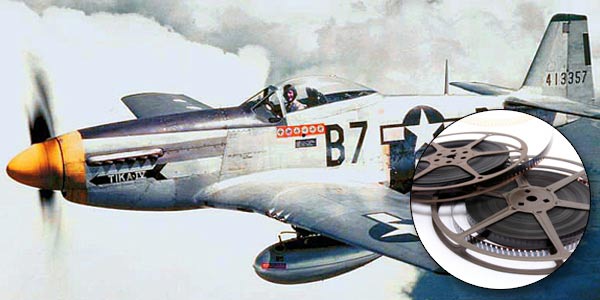
Above: A WWII era P51-Mustang and an example of 16MM film packs.
It’s worth noting that in the late 70’s and early 80’s the first digital instruments came onto the market, for ENDECO they were designed around 8-track audio tapes (the thing that let you listen to the latest Rush album in your car).
When Did You Start Working for YSI?
Mike went on to run the quality department at ENDECO for a brief stint, and it was during this time in 1989 that they were purchased by YSI. In the beginning, this new joint venture between ENDECO/YSI was focused on oceanographic instruments. Things like towed vehicles, wave buoys, current meters, telemetry stations and data logging were their bread and butter. This required lots of fieldwork, and each employee had to learn to wear many hats. There were boats to be sailed to the site, towers to climb so that RF cables could be secured – Mike and his fellow employees had to learn everything on the job – that was simply how things were accomplished. As a result, there were very few specialists and most of what Mike learned was through osmosis – pulling on the experience of his fellow engineers and customers.
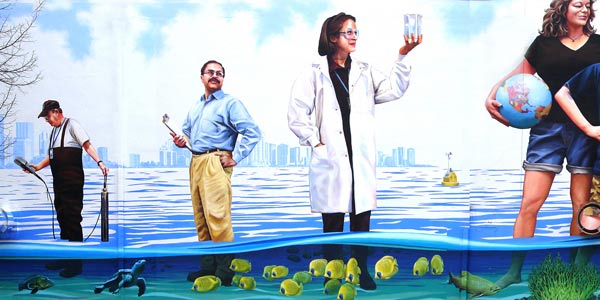
Above: The mural from YSI headquarters in Yellow Springs, Ohio.
In the first few years after being purchased ENDECO kept doing what they did best, but then in the early 1990’s the CEO of YSI, Malte von Matthiessen, decided to go into the multiparameter instrument business with the Model 6000 water quality sonde. ENDECO, and Mike by extension, had lots of knowledge about the Dissolved Oxygen parameter (as they created the 1184 and 1125 pulse DO controllers) so the stage was set for history to be made.
Around 1991-1992 Mike started working with Chief YSI Scientist John McDonald – evaluating and field testing the YSI 6000 Multiparameter Sonde. YSI attempted to sell the instrument through direct sales channels and also through its catalog distribution, but it did not go as planned. The sales figures did not meet expectations, and YSI was not capturing as much of the market as they had hoped. At the same time, ENDECO’s buoy and wave measurement business was starting to decline as well. This was during the “oil days” when prices were way up and gasoline was scarce. The offshore exploration market was collapsing as a result. So CEO Malta looked to ENDECO and said, “You have marine experience – we want you to help us with marketing and selling the Model 6000”. This was the moment when Mike officially starting working directly with YSI Sondes.
What Were Your Major Contributions at YSI?
The Model 6000 was originally designed by people who understood the waste water market more than they understood the scientific arena. An example was the original Model 6000 temperature accuracy was only +/- 0.4 °C, which was insufficient for researchers and the scientific community doing coastal monitoring. It also had a very limited battery life and could not be deployed for very long periods.
Through input from Mike and others at YSI and ENDECO – they produced the 6000UPG (short for upgrade). The focus was to improve the temperature, oxygen, salinity, and depth accuracy, plus the battery life. Key features of the 6000 and 6000UPG design were an oxygen sensor that was flow independent, a conductivity probe that was extremely linear and could be calibrated with a single point, field-replaceable sensors, and new user-friendly software. These changes contributed to increased sales and when going up against competition YSI won more often than not. Customers saw the proof in the pudding when they put the 6000UPG to the test and YSI Sondes gained a reputation for being some of the finest on the market.

Above: A slightly worn and field-proven 6000UPG.
With these design improvements under their belt, the instrument started to evolve into the 6-Series line of sondes. YSI has a belief that customer service needs to be number one and to be a partner with the customer – not just in the business of selling instruments. This meant actually talking and learning from the customer about their unique applications – and then going back to craft a solution to fit their needs. This was an early differentiator for YSI when compared to its competition – it was about listening, paying attention, and not just looking for a quick sale. The evolution of the 6-Series Sonde line reflects the drive to provide solutions as unique as the issues our customers face.
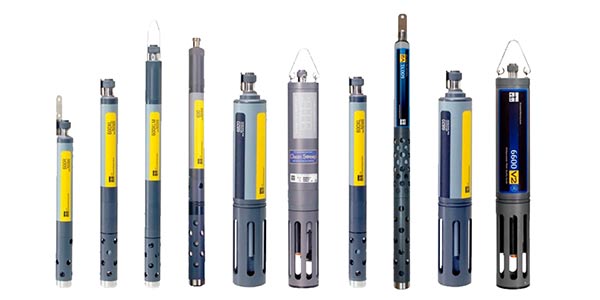
Above: The full 6-Series line of Water Quality Sondes, which changed shape, size, and functionality depending on the needs of the customer.
For example, Mike has a patent from the early 2000’s for the 6600EDS (extended deployment system), which was an attempt to find a way for customers to get better long-term DO data. With the inclusion of the 6562 Rapid Pulse DO probe and the first wiper system for keeping the DO membranes clean – the team quickly realized that they had produced something really useful for the industry. What’s important to remember though is that this all came from trying to create unique solutions for customers and improving their data quality.
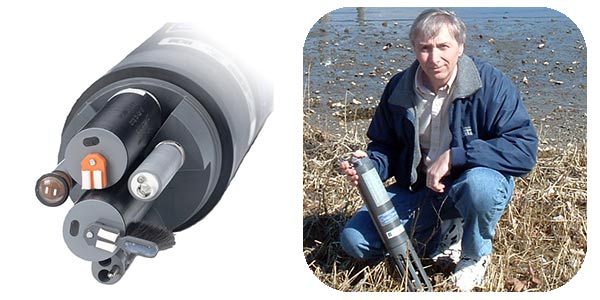
Above: 6600EDS sonde with new wiper system and 6562 Rapid Pulse DO probe, and Mike Lizotte proudly displaying the latest in sonde technology at the time.
Beyond the 6600EDS, Mike’s primary role was to support the customers in the field. Another major project he worked on was called the Long Term Monitoring Project which he spearheaded alongside project lead Rob Ellison. The goal was to take the 6600 instruments (created years earlier in 1998) and find solutions that would be beneficial to the customer that further extends deployment life in the field. Through this work, Mike took many trips to USF (University of South Florida, St. Pete Marine Campus) and in that testing, they evaluated all different kinds of anti-fouling methods. Everything from the copper tape we sell now, to copper alloy sensor guards, copper wipers, and different coatings like sensor sleeves and even duct tape.
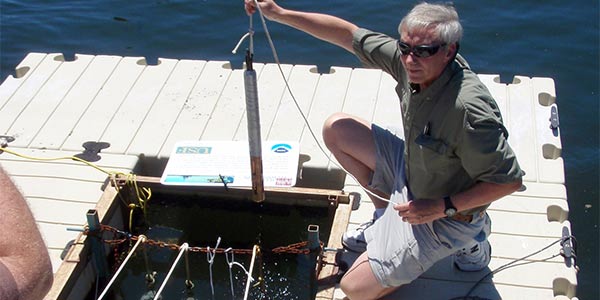
Above: Mike conducting field testing of YSI sondes at USF.
In all of this, the goal was to allow the sonde to stay in-situ for the longest period of time possible while delivering the highest data quality. In addition, all of the testing along the way gave them insights into continued improvements to the existing products – because they were deploying them in some of the harshest deployment environments known in the industry.
This insight ultimately culminated into what was needed for the next generation of sonde, the EXO platform. In 2009 development on the EXO sonde line started proper and launched officially in 2012. Mike believes that learning from customers about where our weaknesses lie really drove YSI to create a unique and powerful instrument in the EXO sonde that has a great deal of future potential.
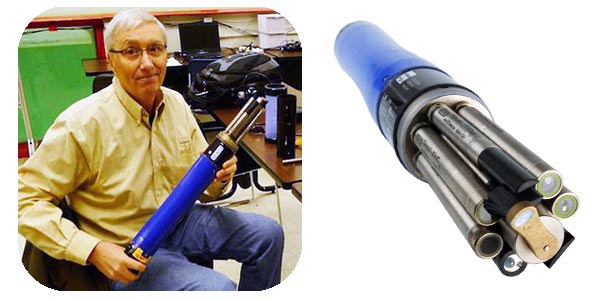
Above: Mike holding an EXO2 sonde early after its release. An EXO2 sonde with central wiper and the new Wiped C/T sensor, the latest development in antifouling technology.
Which Projects or Customers Stand Out in Your Mind?
The NEER’s program (National Estuarine Research Reserve System) really stands out and is closest to Mike. In the launching of YSI products, during testing and putting it through its paces – Mike had a feeling that the NEER’s organization was going to be important as they were one of the first to do such a large-scale nationwide monitoring program.
And as it turned out, NEER’s became a very important player in this industry, and once YSI proved itself NEER’s became a very important partner. The first big sale being 50 instruments, and as an organization today they likely have owned over a thousand YSI sondes. This total occurring over many years, to over 39 NEERS reserves scattered around the country.
What Was the Most Rewarding Part of Your Job?
Simply put, helping people. Mike always enjoyed working with customers and found that in many cases if you listen well – that the solutions to the problem are not as difficult as they first appear. And, also, his belief that the planet is in trouble and problems related to climate change need to be addressed. Freshwater supplies are stressed and with estuaries being the beginning of the food chain it’s an important area to understand and protect if we are to leave our children the same quality of life that we enjoyed. Without good data, we can’t have good science – which means we can’t have a real understanding of the issues we face to address the problem. Mike believes his role was not to solve the problem, but rather to help those who have the ‘brain power’ to make a difference. To help them get the data they need to achieve the goals that will benefit all of us is enough for Mike.
What Was the Most Challenging Part of Your Job?
Mike feels his greatest challenge was the new evolving workplace – in his time, he did what had to be done; climb a tower or drive a boat. A lot of people who come out of school now don’t necessarily know what they don’t know – you come out of school and you believe you’re educated and ready to take on the world – and in reality, your education is just beginning. Some folks don’t quite understand what the needs of the marketplace are, and can end up designing in a vacuum. There is a real need to get more of our technical people out into the field so they can get some real experience in the places these instruments are used. The process of learning never stops, and in this field it never gets boring.
Where Do You See the Industry in the Next 25 Years?
Sensor technology is improving at incredible speed and hopefully, the instrumentation will be designed that can do even longer-term deployments and deliver even higher accuracy data. Robotics will become even more heavily involved with things like AUV’s, and drones taking samples (instead of a person driving around) aerial and underwater vehicles can fly around and take will be able to take readings in more severe weather and at reduced costs. If they are going to be able to deliver packages for Amazon we should be able to use the technology to deliver data.
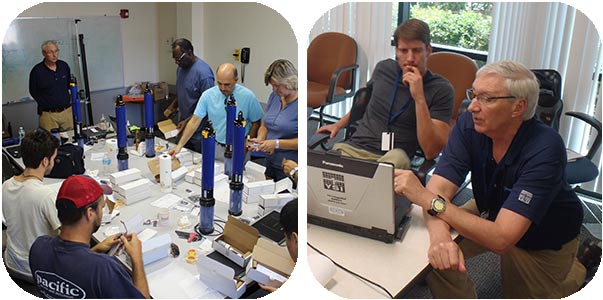
Above: Training the next generation of environmental stewards on YSI technology was a key element of Mike’s responsibilities, and one of the most rewarding.
What Advice Would You Give to Up-and-Coming Water Quality Professionals?
A person in this field has to have patience – patience to learn, and patience to not expect instant gratification. In the early part of his career, there were a lot of times he wanted to quit – when he had to do a job he didn’t like. And yet, he learned from that and it prepared him for new jobs down the road. Now Mike thinks, for some people, they are less willing to stick it out. Some of that has to do with the fact that many folks have very large education bills that need to be paid, rather than sticking it out in a field they love they will jump from position to position to climb the revenue ladder.
So, Mike would say for a WQ professional you have to have patience and you have to have dedication and passion. If you don’t have passion for what you do it’s never going to be rewarding. He meets a lot of people in this industry who could have been other things like doctors or lawyers or pharmacy techs – they could have made a lot of money, they are smart enough to take on other higher-paying careers – but they chose a different path because they care for the planet and the people who live on it – and he has a great amount of respect for those folks because they are following their heart and passion and doing what they believe is right even if the system isn’t going to give them that quick return.
“It is us that must say THANK YOU. Your interaction and support of us on both a personal and program level , has always been outstanding. My only regret is having not been able to work with you more directly as we did in the “early” days. You are truly a great individual and professional that made a difference at many levels. Just too tout a few, you were instrumental in training the current and next generation of water quality monitoring specialists, you helped develop SWMP into a national, high quality coastal water quality monitoring program which is still the bread and butter of NERRS, you displayed an innovative spirit as you helps us “Fight Biofilm” and allowed us to beta test some of your new toys, you supported NERRA at the highest level, you truly were customer oriented to the point of being considered part of the NERR team. Mike, I wish you nothing but the best in your retirement and I hope that it is filled with many adventures.”
William G. Reay, Ph.D.
Director, CBNERR
Research Associate Professor
Dept. of Physical Sciences
Virginia Institute of Marine Science
YSI would like to thank Mike Lizotte for his years of dedication - not just to the business, but for doing his part to make the world a better place. His efforts and positive outlook have left great impressions on the industry from coast-to-coast. From everyone at YSI, we wish you a peaceful and productive retirement!
Additional Blog Posts of Interest
Estuary Research Project Highlights Advantages of Continuous Monitoring
Sea Level Rise Research: Clam Bayou Estuary Florida
Extend Your Water Quality Sonde Deployment Times with Wiped Sensors [Case Study]
Water Quality Monitoring Challenges | 1 of 5